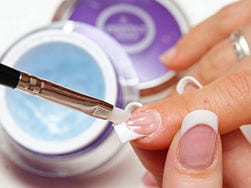Legions of scantily clad coeds and tourists hit South Beach for some mid-winter break fun and sun as thousands of dermatologists huddled in the Miami Convention Center to discuss, among other things, skin cancer risks – including those associated with gel manicures.
Among the highlights of the American Academy of Dermatology’s 71st Annual Meeting in Miami Beach, Fla, were:
Gel Manicures Linked to Nail Problems
Gel manicures may be trendy and last longer than traditional polish, but they also may be damaging to the nail and mask disease, warns Chris Adigun, MD, a dermatologist and assistant professor of dermatology at The Ronald O. Perelman Department of Dermatology at New York University School of Medicine in New York.
According to Adigun, gel manicures may cause nail thinning, brittleness, peeling, and cracking with frequent use and can camouflage nail disease if done repeatedly. In addition, women who frequently get gel manicures should consider their skin cancer risk since the UV light needed to cure the gel manicure is a risk factor for skin cancer. Exactly what it is about gel manicures that may cause these issues is not fully understood yet, but for now it is manicure-lover beware.
Everyone’s Favorite Toxin May Ease Psoriasis, Eczema
New research suggests that botulinum toxin may help treat inflammatory skin diseases such as psoriasis and eczema, according to Erin Gilbert, a dermatologist and assistant professor of dermatology at SUNY Downstate in Brooklyn, NY.
Topical and oral steroids can help treat these conditions, but they are not without their share of side effects namely thinning and lightening of the skin and the development of new blood vessels. “While there are available therapies to treat eczema and psoriasis, in some cases there may be small areas where these therapies are not effective,” Gilbert says in a news release. “In these instances, botulinum toxin injections could hypothetically provide another treatment option and potentially allow patients to stop using topical steroids for a while.”
She adds, “Clinical studies are under way, and it is possible that FDA approval of the neurotoxin for these expanded indications could occur in the not-so-distant future.”
Tattoo You?
Tattooing is on the rise, and dermatologists are seeing a commensurate increase in allergic reactions and serious infections related to tattoo ink, according to a Seattle-based dermatologist.
Tattoo ink has changed a lot in recent years, and today’s inks (especially intense reds and yellows) contain organic azo dyes with plastic-based pigments that also have industrial uses. As a result, there are many unknowns about how these inks interact with the skin and within the body, and if they are responsible for an increasing number of complications, says Michi Shinohara, MD, a clinical assistant professor of dermatology at the University of Washington in Seattle.
Triluma’s back!
Galderma’s Tri-Luma® Cream is back after a noticeable hiatus. Supplies of the melasma treatment dwindled soon after a full recall in late August 2010 due to manufacturing problems, but it is available in pharmacies once again much to dermatologists’ and melasma patients’ delight.






